
By Astrid Leitner - University of Hawaii at Manoa
May 10, 2017
Dive 08 was the deepest dive of the Mountains in the Deep: Exploring the Central Pacific Basin expedition. We targeted abyssal depths around 4,400 meters (14,435 feet!) in order to look at the geology of this portion of the Clipperton Fracture Zone. Although the geologists were interested in looking at the steeper, hard substrate section to collect rock samples, many of the biologists were interested in exploring the soft sediments.
The soft, sedimented abyssal plain has many diverse and interesting animals and is only rarely sampled. This was a great opportunity for abyssal exploration. Several of the participating scientists, including Diva Amon, Jeff Drazen, Craig Smith, and me, were especially interested in the sedimented portion of this dive to compare to our recent observations from the eastern portion of the Clarion-Clipperton Zone, or CCZ (the abyssal area between the Clarion and Clipperton fracture zones).
Traditionally, abyssal plains like the CCZ have been considered to be large monotonous habitats, but there are so few observations across the vast region that we don't really know if the same species are found throughout.
There is growing interest in deep-sea mining in this region. The seafloor around the Clipperton fracture zone area contains valuable metals and rare earth minerals in pebble-like mineral deposits known as manganese nodules. It is important to understand the ecology of this region in advance of any potential mining.
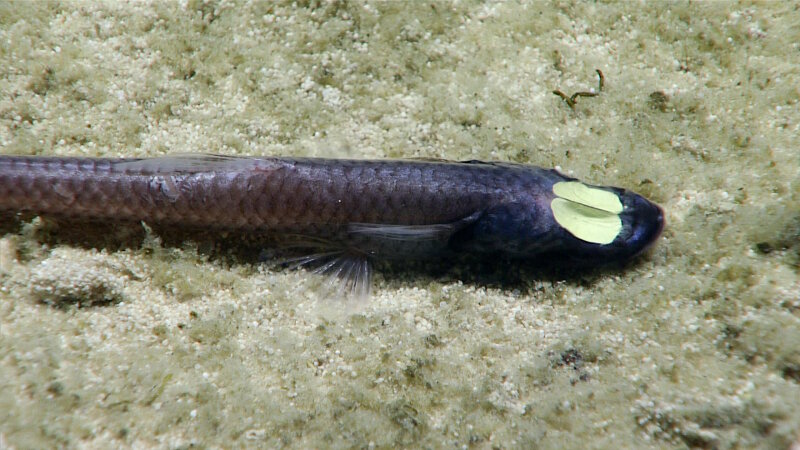
This grideye fish (Ipnops meadi), seen on Dive 08 of the expedition, has highly modified, platelike eyes. These eyes lack a lens and so can only detect the presence or absence of light. Presumably, the eyes function to detect bioluminescence from potential prey items. Image courtesy of the NOAA Office of Ocean Exploration and Research, Mountains in the Deep: Exploring the Central Pacific Basin. Download larger version (1.4 MB).
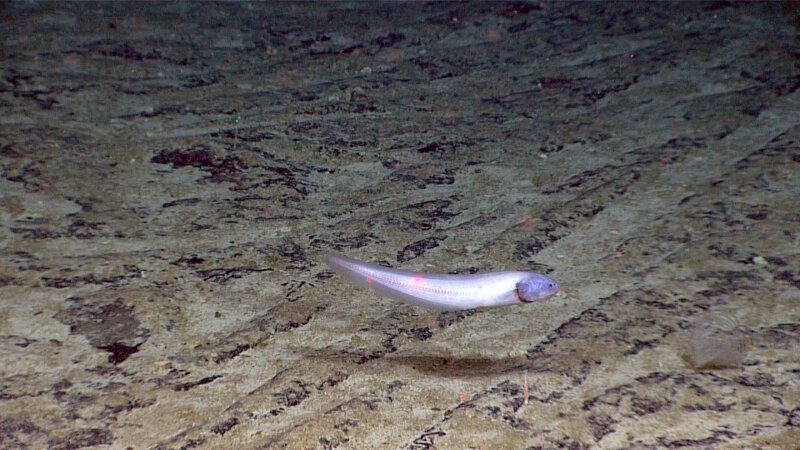
This cusk eel (Bassozetus sp.), seen on Dive 08 of the expedition, was one of the fish we had expected to see during this dive since it is also common further east in the Clarion-Clipperton Zone. Image courtesy of the NOAA Office of Ocean Exploration and Research, Mountains in the Deep: Exploring the Central Pacific Basin. Download larger version (jpg, 1.8 MB).
We saw many, but not all, of the dominant fishes that we previously observed in the eastern CCZ, as well as some different species. The most abundant fishes seen during this dive, and in our work in the eastern CCZ, were grideye fish (family Ipnopidae, Ipnops meadi). Throughout the dive, we saw seven individuals on the soft sediment. These fish are easily recognizable by their amazingly large, reflective eyes.
We observed several cusk eels as well (family Ophidiidae). Cusk eels are known from across the CCZ, but seem to get more abundant as you travel west. Therefore, it was expected to find them at this dive site in the westernmost end of the CCZ. We observed cusk eels in the genus Bassozetus, which have a large, bulbous heads and are frequently observed at baited cameras eating amphipods that come to consume the bait.
We also saw two additonal cusk eel species which were not observed in the eastern CCZ: Leucicorus and a mystery cusk eel, which we haven't yet identified to genus. Leucicorus have a bony-looking head and very large eyes. The first individual observed had a badly damaged head and was even missing an eye!
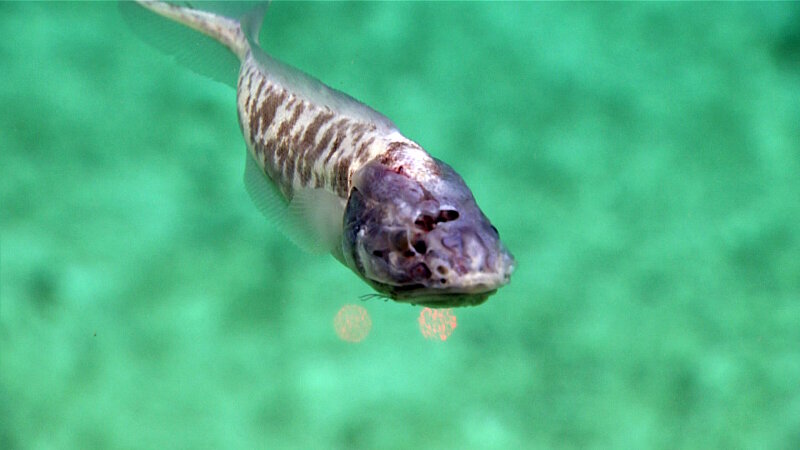
This injured cusk eel (subfamily Neobythitinae, Leucicorus), seen on Dive 08 of the expedition, has a dark head and a lighter, mottled body. Image courtesy of the NOAA Office of Ocean Exploration and Research, Mountains in the Deep: Exploring the Central Pacific Basin. Download larger version (jpg, 1.1 MB).
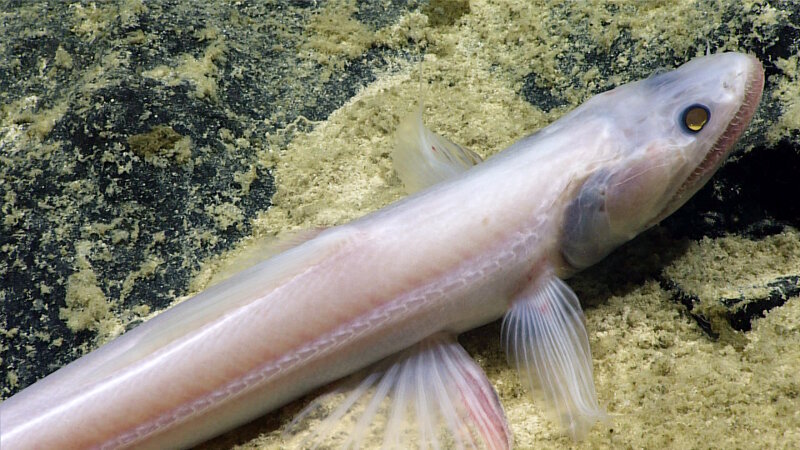
This deep-sea lizardfish (Bathysaurus mollis), seen on Dive 08 of the Mountains in the Deep expedition, is a top predator on the abyssal plains. Image courtesy of the NOAA Office of Ocean Exploration and Research, Mountains in the Deep: Exploring the Central Pacific Basin. Download larger version (jpg, 1.5 MB).
This damage was likely due to an attack from a top predator such as a Bathysaur, a lizardfish which was also observed on this dive. Bathysaurus have beautiful, yellow eyes and a mouth full of impressive teeth. They are apex predators in the abyss and are known to strike at other large fishes. These lizardfish are widely observed on abyssal plains, including in the eastern end of the CCZ. We were able to identify them down to species (Bathysaurus mollis) due to their pale coloration.
We also observed one rattail (family Macrouridae, Coryphaenoides sp.). Rattails are dominant scavengers in the eastern side of the CCZ. Interestingly, we observed no eelpouts (Zoarcidae) or cutthroat eels (Synaphobranchidae), although they have been observed in other areas of the CCZ.
Another interesting observation made during this dive was the frequently seen bicolor pigmentation pattern with a darker head and a lighter body. This pattern was seen in all the ophidiids observed at this site, even though cusk eels can come in a range of color morphs. There may be some geographic patterning in color morphology such that some color patterns are more frequent in certain locations, but we don't yet have enough data to fully evaluate this hypothesis.
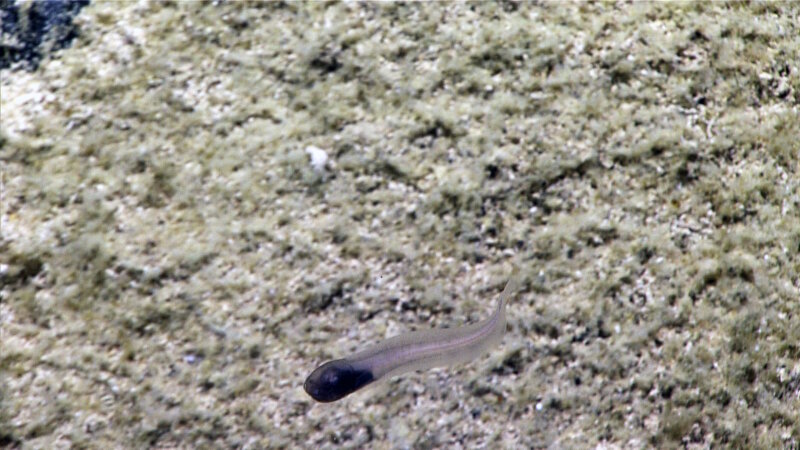
This unknown cusk eel (family Ophidiidae), seen on Dive 08 of the expedition, also displays a bicolor pigmentation pattern with a dark head and a light body. Image courtesy of the NOAA Office of Ocean Exploration and Research, Mountains in the Deep: Exploring the Central Pacific Basin. Download larger version (jpg, 1.3 MB).
There seems to be an interesting biogeographic story behind the distribution of abyssal fishes throughout the CCZ and across the Pacific, which we are just beginning to understand. Classically, abyssal plains have been considered to be expansive, homogeneous, and monotonous habitats. However, as we continue to explore the abyssal plains, interesting features – such as fracture zones, abyssal hills, and seamounts – and interesting ecological patterns are beginning to emerge. For example, it seems that rattail fishes are gradually replaced by cusk eels as you move westward across the Pacific.
The abyssal plains are one of the largest habitats on our planet, and to understand the communities that thrive there, we must continue to explore these remote locations.